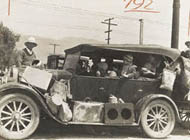Grades/Level: Middle School (6–8), High School (9–12) |
|
||||||||||||||||||||||||||||||||||||||||||||||||||||||||||||||||||||||||||||||
Lesson Overview |
|||||||||||||||||||||||||||||||||||||||||||||||||||||||||||||||||||||||||||||||
Students examine primary resources, photographs by Dorothea Lange, and a U.S. map to understand the migrant experience during the Great Depression |
|||||||||||||||||||||||||||||||||||||||||||||||||||||||||||||||||||||||||||||||
Learning Objectives |
|||||||||||||||||||||||||||||||||||||||||||||||||||||||||||||||||||||||||||||||
• Students will analyze primary resources and a map in order to draw conclusions regarding the migrant-worker experience during the Great Depression. |
|||||||||||||||||||||||||||||||||||||||||||||||||||||||||||||||||||||||||||||||
Materials |
|||||||||||||||||||||||||||||||||||||||||||||||||||||||||||||||||||||||||||||||
|
|||||||||||||||||||||||||||||||||||||||||||||||||||||||||||||||||||||||||||||||
Lesson Steps |
|||||||||||||||||||||||||||||||||||||||||||||||||||||||||||||||||||||||||||||||
1. Review Dust Bowl terms and history. "And then the dispossessed were drawn West—from Kansas, Oklahoma, Texas, New Mexico; from Nevada and Arkansas, families, tribes, dusted out, tractored out. Car-loads, caravans, homeless and hungry; twenty thousand and fifty thousand and a hundred thousand and two hundred thousand. They streamed over the mountains, hungry and restless—restless as ants, scurrying to find work to do—to lift, to push, to pull, to pick, to cut—anything, any burden to bear, for food. The kids are hungry. We got no place to live. Like ants scurrying for work, and most of all for land."
4. Provide handout of U.S. map with questions. Have students locate and label the items on their maps, explaining the significance of these locations to the Dust Bowl. Point out the states Steinbeck mentions in the excerpt.
6. Hand out copies of the San Francisco Chronicle newspaper article and read aloud. Have students write out answers to the following questions independently.
7. Discuss the article and compare it with the images of Highway to the West and Dust Bowl Refugees. From whose point of view is this article written? Whose point of view do you think Lange was trying to express in her photographs? And from whose point of view was Steinbeck writing? How is a photograph similar to or different from text? What can a photograph tell you that a written text cannot, and vice versa? |
|
||||||||||||||||||||||||||||||||||||||||||||||||||||||||||||||||||||||||||||||
Assessment |
|||||||||||||||||||||||||||||||||||||||||||||||||||||||||||||||||||||||||||||||
• Teacher observation of class discussion, or evaluation of written work. Students should be able to critically analyze and show an understanding of photographs and/or newspaper article. |
|||||||||||||||||||||||||||||||||||||||||||||||||||||||||||||||||||||||||||||||
Extensions |
|||||||||||||||||||||||||||||||||||||||||||||||||||||||||||||||||||||||||||||||
• Students might write a diary entry or letter from one of the following points of view:
• Students could read and report on The Grapes of Wrath by Steinbeck. |
|||||||||||||||||||||||||||||||||||||||||||||||||||||||||||||||||||||||||||||||
Standards Addressed |
|||||||||||||||||||||||||||||||||||||||||||||||||||||||||||||||||||||||||||||||
Common Core Standards for English Language Arts |
|
||||||||||||||||||||||||||||||||||||||||||||||||||||||||||||||||||||||||||||||



